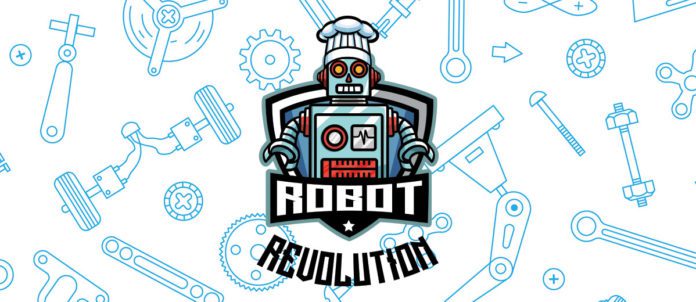The robot revolution is here and it’s sweeping across the foodservice landscape in Canada and around the world. Pandemic pressures have catapulted a new wave of automation to relieve labour shortages, reduce food contamination, eliminate errors, increase productivity and provide contactless customer experiences.
Toronto-based SJW Robotics has introduced a fully autonomous robotic restaurant called RoWok. The 100-sq.-ft. unit can produce 60 Asian noodle dishes per hour and is suitable for spaces that are too small for an onsite kitchen or where staff aren’t available 24/7. This includes airports, hospitals, universities/colleges and shopping malls. A few onsite staff are required to prep, stock and monitor the quality of product and service. Menu options include ginger edamame noodles, hoisin tofu noodles, beef and broccoli noodles, Kung Pao Chicken and more. Most recently, Mississauga, Ont.-based Compass Group Canada partnered with SJW Robotics to pilot three RoWok restaurants across Ontario. This fall, the machines will be installed in the healthcare, business and industry and educational spaces.
“Our team saw an opportunity to vastly improve customer experience for great foodservice options that are warm and customizable, especially in situations that are underserved, such as off-peak hour service,” says Heather Wilkie, VP of Innovation, Compass Group Canada. “The technology within RoWok takes a traditional foodservice model and shifts it, allowing us to use an innovative approach to close a gap and increase guest satisfaction.”
The BellaBot, developed by Shenzhen, China-based Pudu Robotics, was first introduced to the North American market by GreenCo Robotics, headquartered in Edmonton. The BellaBot resembles a cat and features an upward-facing infrared camera and four trays to transport dishes to and from restaurant kitchens. It also has hostess abilities and directs diners to their seats. Depending on the model and warranty package, the pricing ranges from $26,000 to more than $30,000. Within Canada, there’s between 300 and 400 restaurants using the BellaBot.
“We believe robots were invented by humans so humans don’t have to be robots,” says Liang Yu, president and CEO, GreenCo Robotics. “The robot can complete more tasks so serving staff have more time with customers. Servers can also make more tips because they don’t have to share tips with the robot. It’s a win-win-win situation for the owner, staff and our economy by attracting more customers to on-premise dining post-pandemic.”
Toronto-based Tiny Mile has created pink delivery robots named Geoffrey for contactless food delivery. Geoffrey can carry up to 6 lbs. in its locked truck and deliver within a one-mile radius from a downtown Toronto restaurant in 15 minutes. Geoffrey is also battery powered and controlled remotely by a pilot, making it an environmentally friendly solution while helping businesses cut delivery commissions in half. Toronto-based Snappy, a restaurant tech company, partnered with Tiny Mile to bring this delivery option to its restaurant customers, including The Fourth Man in the Fire Pizzeria, Thai Basil, Aroy Urban Thai Queen, House of Gourmet, Hey Noodles and more.
“Snappy is an all-in-one solution for restaurants to manage their customer experience, which means we’re always on the lookout for innovative and cost-effective ideas to help our customers manage their restaurants efficiently and this partnership fits with that mission,” says Ricky Wang, co-founder and CEO of Snappy.
South of the border, California-based Miso Robotics introduced Flippy back in 2017, a robotic arm that uses computer vision and machine learning to operate grills and fry baskets. The company recently introduced Flippy 2, which is twice as fast as its original model and can produce 30-per-cent more fried food. It can handle roughly 60 baskets per hour and starts at US$3,000 per month. In fall 2021, White Castle teamed up with Miso Robotics to launch a pilot program at its Chicago location. Currently, Flippy 2 is installed in three White Castle locations, with plans to install the robot at 100 restaurants over the next several months. Recently, Miso Robotics partnered with Jack in the Box, Wing Zone and Wings and Rings for Flippy 2 pilots. Other products include Flippy Lite, Sippy and CookRight.
“Staff shortages have always made operational success difficult, and we’re seeing an all-time high number of open positions and amplified turnover rates across the U.S.,” says Michael Bell, CEO, Miso Robotics. “Through our technology, we seek to offload some of the labour-intensive, dangerous and repetitive tasks in the back-of-house.”
“Miso Robotics has been an excellent partner, providing us the opportunity to make sure Flippy is able to provide significant support to our restaurant operations teams,” says Jamie Richardson, vice-president at White Castle. “When we invest in technology that allows us to improve operations, it also frees our teams up to interact with our customers in an even more meaningful way. We’re excited about the future of food and the tools our industry will be able to employ to allow our collective heart for hospitality to shine even brighter.”
By Nicole Di Tomasso


















